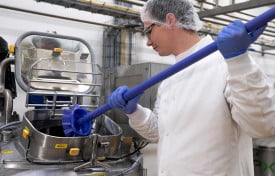Laboratory & QA/QC

- May 06, 2015
Listeria, a bacterium responsible for listeriosis, presents a significant concern due to its relatively high mortality rate, leading to approximately 260 deaths annually in the United States, according to the Centers for Disease Control. Unlike some isolated super-bug, Listeria monocytogenes is commonly found in soil and water, and animals can carry the bacterium without showing signs of illness, potentially contaminating foods of animal origin. Moreover, when Listeria enters a food processing factory, it can persist for years, posing a threat to food products. Consumers and food processors alike are keenly aware of the need for effective prevention measures. While consumers can refer to resources like the CDC and FDA for prevention information, food processors must focus on stringent practices and standards. Areas such as cleaning and sampling, ensuring proper temperatures during processing, and implementing strategies to prevent cross-contamination play a crucial role in minimizing the
- January 21, 2015
“You could also ask who’s in charge. Lots of people think, well, we’re humans; we’re the most intelligent and accomplished species; we’re in charge. Bacteria may have a different outlook: more bacteria live and work in one linear centimeter of your lower colon than all the humans who have ever lived. That’s what’s going on in your digestive tract right now. Are we in charge, or are we simply hosts for bacteria? It all depends on your outlook.” - Neil deGrasse Tyson, Space Chronicles: Facing the Ultimate Frontier.
As funny as that may sound and as puzzling as it may be to think about, it is true. Bacteria are everywhere; most of them are good and normal and are absolutely necessary for the maintenance of our health, environment, and well-being. They are responsible for some of the best things (in my book) in life…like cheese, beer, and wine. But when the wrong bacteria get into our food supply, the results can be disastrous.
Historically, testing for the presence of what is known as an indicator organism in our water and food supply, has played a significant role in the food industry. These levels are monitored as indicators of food quality, food safety, and a marker of the overall hygienic status of the production facility. E.coli, Coliforms, and Enterobacteriaceae are three indicators that have been, and are currently used in the industry.
In 1887 a well-known bacteriologist, Theodor Escherich, observed a pervasiveness of organisms now known as Esherichia in human stools. Later, E.coli and other organisms were used to indicate the potential presence of pathogens in water. In 1915, the U.S. Public Health service changed this standard indicator from E.coli to Coliforms. Using E.coli and Coliforms as indicators of water safety and quality eventually spread to testing for these organisms in other foods. First, pasteurized milk and dairy products were tested and then an array of other foods followed.
- October 20, 2014
Discover precision in chloride and salt content measurements with the Nelson-Jameson M926 Chloride Analyzer – an indispensable addition to your laboratory toolkit. This renowned instrument ensures accuracy in assessing chloride levels across a diverse range of food and product samples. Delve into the functionality of the M926 Chloride Analyzer through the informative videos provided below. The "M926 Chloride Analyzer Basics Video" guides you through essential steps such as setup, conditioning, and control checks, offering valuable tips for optimal use. Explore further with the "M926 Chloride Analyzer Procedures Video," covering display options, sample preparation, titration, calculations, results averaging, software insights, and more. Elevate your analytical capabilities and streamline your chloride measurement processes with the insights provided by these instructive videos.
- May 07, 2014
A year or so ago, I was sitting comfortably in a classroom proctoring an exam. Freshly tenured, a few books and articles written, and now an associate professor in the humanities, I should have been feeling pretty content. My former Ph.D. student self would have thought so…yet, my mind was wandering. As students filled out their exams on film history, I couldn’t help but ponder what necessary standards potentially were used for the bottled iced coffee with milk beverage that I was drinking that evening. How was the milk procured? What did their facility look like where they brought these ingredients all together? Did they monitor temperature during transport? Was it properly handled when it was shelved at the convenience store? How had pH levels been monitored throughout the process?
Yes, this would just seem like neurosis to many; however, there was something more going on…The past five years I had been doing research and writing for Nelson-Jameson on the side, in the hopes of filling in some economic gaps left by my then current position. Over the course of those several years, my research heavily focused on food safety and quality control/assurance. Far from neurosis, the clouds parted that night when I realized I was staring into the face of a passion that had developed (no, not an appreciation of iced coffee), the want to help provide a safe, quality food supply.
I suppose slowly, the research methodologies and patterns of critical thought/engagement I was so comfortable with in my work at the university, seeped into pursuing this topic. Yet, I had never seen this path coming. So when I had the opportunity afforded to me to continue on this trail as a manager of the Laboratory Products area, I jumped on it.
- April 23, 2014
Navigating the vast array of pH electrodes to find the perfect fit for your application can be a daunting task, given the multitude of options available. This comprehensive selection guide serves as a valuable resource to ensure that you make the right choice when ordering a pH electrode tailored to your specific needs. Exploring the distinctions between gel-filled and refillable electrodes, glass and epoxy body designs, bulb variations, and reference chemistry, the guide offers insights into crucial features that impact electrode performance. From the ruggedness of a semi-dome design to the temperature resistance of glass bodies, each aspect is meticulously covered. The guide delves into the intricacies of reference design, emphasizing the importance of preventing contamination and presenting alternatives like double-junction or calomel electrodes. Brands such as Oakton, Pinnacle, and Thermo Scientific Orion are highlighted, offering a diverse range of electrodes with varying features







